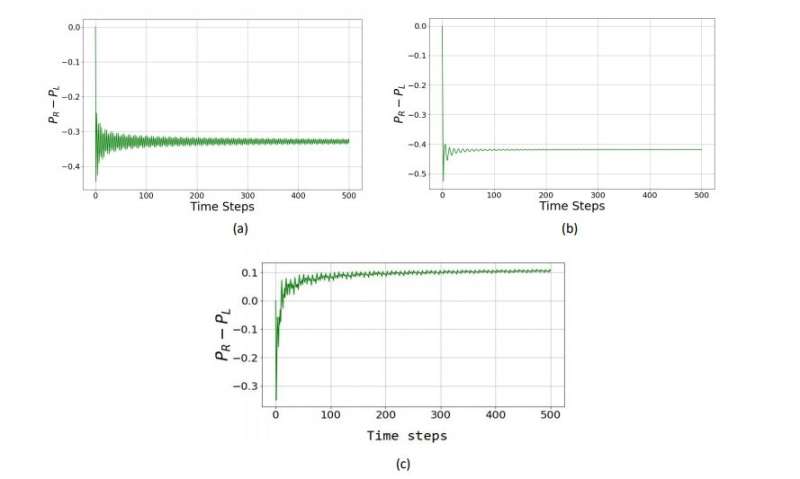July 11, 2018 feature
Parrondo's paradox with a three-sided coin

Physicists have demonstrated that Parrondo's paradox—an apparent paradox in which two losing strategies combine to make a winning strategy—can emerge as a coin game with a single coin in the quantum realm, but only when the coin has three states (heads, tails, and a side) rather than the conventional two.
In general, Parrondo's paradox, also called a Parrondo's game, only works when the two losing strategies are somehow dependent on each other and are combined in such a way as to change the conditions that lead to them losing. Ever since it was discovered by physicist Juan Parrondo in 1996, Parrondo's paradox has found applications in engineering, finance, and evolutionary biology, among other areas.
One of the simplest ways to implement a Parrondo's game is described in this Wikipedia entry. Suppose you have $100, and you can choose to play any combination of two games. In the first game, you lose $1 every time you play. In the second game, you win $3 if you have an even number of dollars left, and you lose $5 if you have an odd number of dollars left. If you only play the first game or only play the second game, you will eventually lose all your money, so playing each game by itself is a losing strategy. However, if you alternate between the two games, starting with the second game, then you will win $2 for every two games you play, so the two losing strategies can combine into a winning strategy.
In the new study, physicists Jishnu Rajendran and Colin Benjamin at the National Institute of Science Education and Research, HBNI, in India, have demonstrated a Parrondo's game using a three-state coin, which they represent with a qutrit, a quantum system with three states.
"Parrondo's games have been seen in a classical context," Benjamin told Phys.org. "Our aim in this work was to show how to implement it in a quantum context, in particular in a quantum walk. Unfortunately, the quantum version of this game when implemented with a single coin (qubit) in a quantum walk failed in the asymptotic limits. What we show in this work is that a qutrit can implement this Parrondo's game in a quantum walk."
In the quantum walk, a player starts at the origin and moves either right (positive direction) or left (negative direction) according to the result of a coin toss. If heads, the player moves right; if tails, left; and if the result is "side," then the player interprets that as a "wait state" and stays in the same place. As the qutrit is a quantum system, it can also be in a superposition of these states, in which case the player moves to a corresponding position, somewhere in between a full step left or right. At the end of the game, if the probability that the player is found to the right of the origin is greater than the probability of being found to the left of the origin, the player wins. Otherwise, they lose.
Using some of the standard methods in particle physics to define the concepts of a coin toss and game rules with a superposition of states, the physicists demonstrated several examples of games that result in losing when played individually, but when combined in an alternating sequence result in a winning outcome. They also demonstrated examples of the reverse. For example, two games that result in a win and a draw when played individually can result in a losing outcome when combined.
The physicists also showed that, although it's not possible to implement a Parrondo's game using a single two-sided coin (qubit), it is possible to implement a Parrondo's game using two two-sided coins (two qubits). The additional states essentially provide additional flexibility with which to combine strategies that can overcome the conditions of losing.
Given the broad applications of classical Parrondo's games, the physicists expect that quantum version may lead to new insight into designing quantum algorithms.
"Parrondo's game is a recipe for proving one need not always search for a winning strategy (or algorithm) in a game," Benjamin said. "Classically, there are many applications of Parrondo's games, ranging from explaining physiological processes in the cell to increasing our understanding of Brownian motors and even in diversified portfolio investing. Classically, Parrondo's paradox has been shown to work using classical random walks.
"Implementing a Parrondo's game in a quantum walk would have implications for devising better or faster quantum algorithms. An algorithm which uses quantum principles like superposition and/or entanglement is a quantum algorithm. An algorithm, if it can be implemented on a quantum walk, would be more lucrative than one which can only be implemented on a classical random walk. As quantum walks spread quadratically faster than classical random walks, an algorithm implemented on a quantum walk will take much shorter time to complete than one on a classical random walk. Further, the successful implementation of Parrondo's game on a quantum walk provides an algorithmic explanation for quantum ratchets [systems that have motion in one direction only]."
More information:
Jishnu Rajendran and Colin Benjamin. "Playing a true Parrondo's game with a three-state coin on a quantum walk." EPL. DOI: 10.1209/0295-5075/122/40004
Also at arXiv:1710.04033 [quant-ph]
Journal information: Europhysics Letters (EPL)
© 2018 Phys.org




















